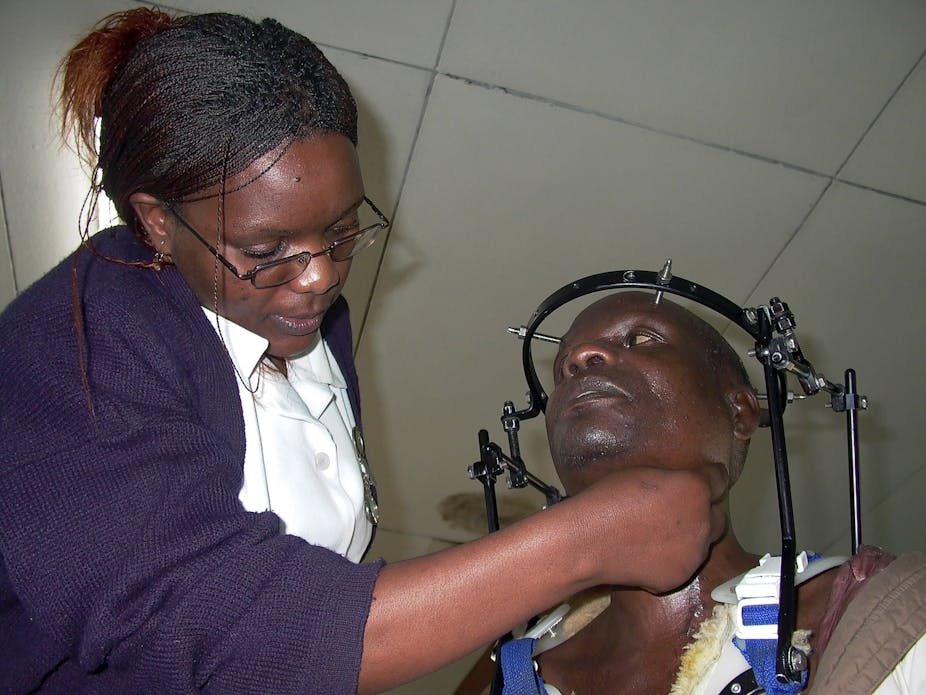The International Monetary Fund’s (IMF) recent decision to withhold its latest loan money to the Malawian government could have dire implications for the provision of health care in the country.
In response to the loan freeze, Malawi has put on hold the hiring of 51 medical graduates and a host of nurses and health professionals to cut its burgeoning wage bill.
The IMF is holding back a US$20 million disbursement of the US$150 million loan facility it has with Malawi because the country failed to meet some of the loan conditions. This was partly due to overspending on the wage bill but it was also exacerbated by revenue and external financing shortfalls. The extended credit facility is the fund’s tool to lend at zero interest to low-income countries.
It is not the first time that Malawi’s funding has been withheld. In October 2013, after it was discovered that US$45 million in public funds had been stolen, donors also withdrew funding. Donor funding used to account for as much as 40% of the country’s budget.
The need for doctors
The latest delay means that the nurses and other health professionals (except doctors) who were earlier offered employment contracts had their offers rescinded after the IMF’s visit in September.
By not employing the intern doctors Malawi will miss out of the clinical services that junior doctors provide. It will also have wasted millions of dollars spent on their training. The medical program at the University of Malawi takes six years, and the government spends US$10,000 on each student annually.
Anecdotal evidence in the last few years shows that Malawai has managed to retain more than 90% of these intern doctors.
There has been a common narrative that low-income countries do not have the necessary doctors to service their health sectors because of low production from medical schools as well as the brain drain.
Malawi does not have a brain drain problem but it does have other challenges. Research shows that Malawian health facilities have a 65% vacancy rate for nurses and nurse-midwives. It put the doctor-to-population ratio at 0.2 doctors for every 10,000 people. The nurse-to-population ratio is 3.4 for every 10,000 people – one-third of the World Health Organsation’s recommended ten nurses for every 10,000 people.
In Malawi, just over 10% of the of the population between the ages of 15 and 49 years are living with HIV. It is estimated that 55,000 new HIV infections occur every year.
Healthcare challenges in Malawi include inadequate human resources and a skewed distribution that favours urban areas. There is also inadequate financing, infrastructure and equipment for Malawi’s estimated population of 16 million.
The health system has been largely supported by “development partners”. In the 2014-15 financial year, US$4.5 million (K65.2billion) of its US$122 million (K635.6 billion) went to health. Foreign grants made up 14.7% of the budget.
The intern doctors were due to participate in an 18-month internship, which needs to take place for them to receive regulatory body licences (the Malawi Medical Council of Malawi). Their internships are split into three months tranches in internal medicine, paediatrics and child health and two six-month stints in surgery and obstetrics and gynaecology.
Only two public tertiary care hospitals, Kamuzu Central Hospital and Queen Elizabeth Central Hospital, are accredited to host the interns. The interns are employed within the civil service as Professional Grade Eight officers. This is the second-lowest graduate among new entrants with a first degree into the civil service.
A medical doctor who has not completed their internship, by law, cannot be registered or licenced. No licence means that one may not be employable or practice independently. However, doctors can complete their internships in any other country, which will allow them access.
Task shifting
The health system has heavily relied on task-shifting – a strategy where non-qualified (often non-medically qualified) health workers are given responsibilities normally performed by highly qualified and highly skilled professionals.
Task-shifting gained momentum in 2004 when Malawi’s when anti-retroviral treatment was initiated and needed to be scaled up amid a shortage of medical doctors.
Until recently, task-shifting was said to be on account of lack of adequate numbers of doctors. But with the excess junior doctors available but not employed, it will be interesting to understand the government’s explanation for shifting the healthcare responsibilities to non-physician cadres.
Finding an alternative
The responses to the doctor hiring freeze have varied. In October, the Doctors Union of Malawi and the Society of Medical Doctors issued an ultimatum to the government to employ the junior doctors or there would be a nationwide strike.
The strike has not taken place, partly due to a lack of consensus among the doctors represented by the union and society. Some activists, who appear not conversant with the concept of medical internship, have called for the removal of the internship before the doctors can be fully registered. There have also been reports that just under half of these junior doctors have left for Lesotho, where they received employment.
The current stalemate is that the Malawi government has been pushed to the wall: if the country wants to satisfy the IMF, then is must not employ the doctors.
The long-term solution is a Malawi that does not need the IMF or World Bank loans and grants. How such a Malawi will emerge is not clear to many.
Going forward an alternative may be for Malawi to consider whether health facilities run by religious denominations, such as the Christian Health Association of Malawi, and selected private hospitals could host interns. This would remove the burden on the Ministry of Health as the sole entity for training interns.
But these other facilities need resources themselves in terms of specialist doctors’ posts and commensurate equipment and patient load. And it would mean that the junior doctors could be employed and service the people who need health care most.

